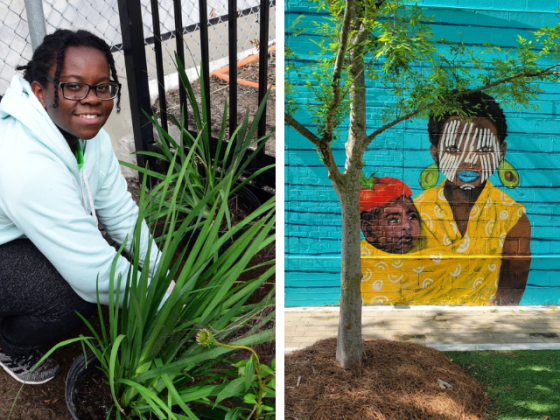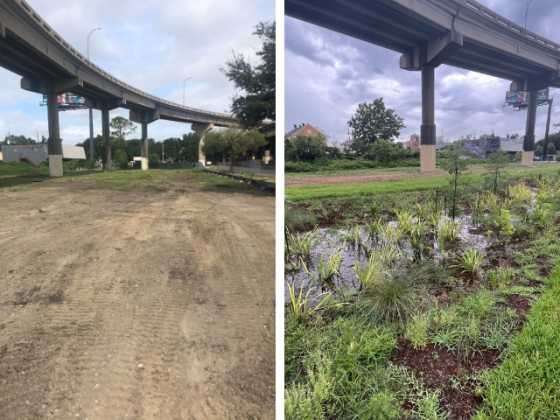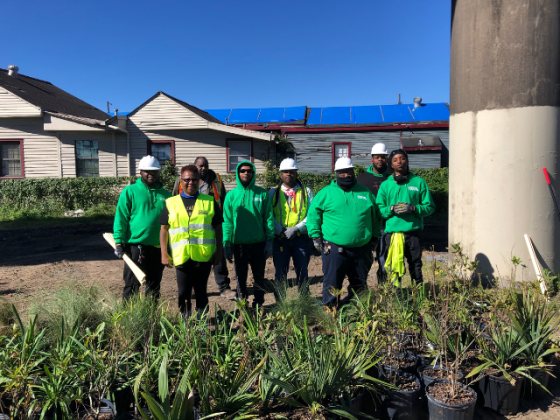Why can’t people in the 7th Ward, a predominantly black and low-income community, have a ‘Legacy Park’? Why can’t they have green space, with green infrastructure amenities, where they can go outside and enjoy themselves?
In the late 1960s, the city of New Orleans approved the construction of an overpass above North Claiborne Avenue in the Tremé district of the 7th Ward, the oldest Black neighborhood in the United States. But while the city uprooted generations of oak trees and divided streets, the residents in Tremé remained grounded and strong. Their resilience and spirit still shine through Second Line parades and gumbo festivals that continue to take place decades later on the same streets that now run under the highway.

Despite the resilience of the residents, the construction of the highway was not free of consequences. Today, every rainstorm floods the streets and overburdens the stormwater systems. Every summer heatwave is dangerously hot in Tremé without greenery to cool down temperatures. Groundwork New Orleans and several other community-based organizations are working to make this district a safe, healthy, and welcoming place for its residents again by installing green infrastructure and community parks. It’s more than just green infrastructure, according to Todd Reynolds, Executive Director of Groundwork New Orleans; it’s about community resilience.
- Groundwork New Orleans does a lot of work city-wide, but you’ve also focused on reviving and restoring the 7th Ward neighborhoods, like Tremé. What inspired you to take action in this area?
It all started with Legacy Park. When I became Executive Director in December 2018, I got a request from the Downtown Development District, an organization that to provides services in economic development, cleaning, and safety to New Orleans, to build a new park to create greenspace in the concrete-heavy downtown. For this project, we removed about 100 yards of concrete and created a stormwater management system, which prevents 27,000 gallons of rainwater per rainstorm from flooding the streets.

A big focus of mine is youth and workforce development. Through every project, I wonder, ‘How many opportunities can we create for young people in the city to get real and genuine certifications for employment?’ whether it’s working for us or not. The Green Team and the Ground Corps, our youth employment and career training programs, helped to complete this project by removing pavement and planting native trees and plants. Legacy Park is more than a park. It has become a vital community space enjoyed daily from morning to night.
Because of how easy it was to raise money for Legacy Park, we began to ask, Why can’t people in the 7th Ward, a predominantly black and low-income community, have a ‘Legacy Park’? Why can’t they have green space, with green infrastructure amenities, where they can go outside and enjoy themselves?
Angela Chalk, the Founder and Executive Director of Healthy Community Services, saw what we did at Legacy Park. She reached out to Groundwork New Orleans to work together to build climate-resilient infrastructure in the Tremé neighborhood. We are now in phase II of the Vision to Reality Park along Claiborne Avenue.
- Why was North Claiborne Avenue in the Tremé a significant area to focus on for a climate-resilient project?
The corridor was originally a forest, with trees for miles and miles. We had a park that stretched 10 – 15 miles long. Additionally, it was an area with a thriving Black community and popular businesses. Then, with urban renewal, groups decided to tear it down and drop in an overpass, creating environmental, social, and economic injustices.
New Orleans is situated between levees along the Mississippi River and Lake Pontchartrain, creating a “bowl” effect. When it rains, even lightly, water floods the city streets. The 7th Ward has hills and valleys and sits close to the bottom of the “bowl.” With little green space to absorb the rainwater, the flooding along Claiborne is intense and frequent. The community deserves a space that doesn’t flood, where they can walk outside their house when it rains and enjoy some green space. It’s simply an environmental justice issue.
Unfortunately, the overpass is not coming down. Our main objective is to create a green space outside where community members can gather again. Second Line and Mardi Gras parades take place along this route, and there are still plenty of clubs and organizations built and maintained by the residents. So, there’s a general need for these communities to have a space to connect – and they deserve to do so in a place free from stormwater flooding.

- Groundwork New Orleans continues to work throughout the city, installing green infrastructure to mitigate flooding and heat and creating parks for people, jobs, and career paths. What’s next for the residents in the 7th Ward?
Many promises have been made and broken regarding greenspaces and investment in these neighborhoods. We want people to know this is real, that we’re not going anywhere, and that we’re building high-quality projects for them to enjoy. As they see us moving, they’ll see the project pick up steam and know we are building a space that truly belongs to them.
We are in phase two of the Claiborne Avenue project- Vision to Reality Park. During the first phase, we constructed a stormwater management system to reduce flooding. During the second phase, we’re focused on creating a space for the community to hang out and enjoy the outdoors. The site will have mature trees, bioswales, and a solar-powered eco-bench for people to charge electronics and receive live weather updates.
These projects have spurred a lot of conversation and action around community and environmental resilience. Moreover, we want to prove to the community that we aren’t a hit-and-run organization. We are committed to building green, climate-resilient spaces for the community to benefit from and enjoy.
There are multiple opportunities along the Claiborne corridor where we can do the same thing we did in Tremé. We can mimic that four or five times, giving folks from different neighborhoods along the corridor access to open green spaces. The value is endless; training for young people, more climate-resilient communities, and reconnected neighborhoods.

Todd Reynolds joined the Groundwork network in 2018 as Executive Director for Groundwork New Orleans. His professional career has been devoted to advocating for under-resourced communities and young people. To find out more about the 7th Ward projects, check out the Groundwork New Orleans Climate Safe Neighborhoods story map!
